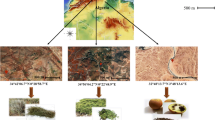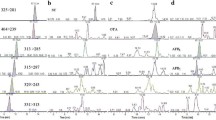Abstract
The ability of fungi isolated from stored herbal drug plants to produce mycotoxins in semisynthetic media was studied. The results obtained show that aflatoxins and ochratoxin A, were produced by Aspergillus flavus, A. parasiticus and A. ochraceus isolates. The time-production courses of aflatoxins B1, B2, 1 and ochratoxin A in crude herbal drug preparations show that more of these toxins were produced with increase in time of storage of the drugs. The results indicate that the potential exists for the toxigenic strains to elaborate mycotoxins in a large quantity in herbal drug substrates than in semisynthetic media.
Similar content being viewed by others
References
Efuntoye MO. Fungi associated with herbal drug plants during storage. Mycopathologia 1996; 136; 115–118.
Deacon JW. Introduction to Modem Mycology. 2nd ed. London: Blackwell, 1980.
Cole RJ, Cox RH. Handbook of Toxic Fungal Metabolites. New York: Academic Press.
Smith JE, Moss MO. Mycotoxins: Formation, Analysis and significance, New York: John Wiley & Sons, 1985.
Roy AK, Sinha KK, Chourasia HK. Allatoxin contamination of some drug plants. Appl. Environ. Microbiol. 1988; 54: 842–843.
Roy AK, Chourasia HK. Mycoflora, mycotoxin producibility and mycotoxins in traditional herbal drugs from India. J. Gen. Appl. Microbiol. 1990; 36: 295–302.
Horie Y, Yamazaki M, Mitake S. On the toxigenic fungi contaminating herbal drugs. II Floral and mycotoxicological survey of fungi in herbal drugs as raw materials in pharmaceutical industries. Trans. Mycol. Soc. Jpn. 1982; 23: 435–447.
Narita N, Suzuki M, Udagawa S, Sekita S, Harada M, Aoki N, Tanaka T, Hasegawa A, Yamamoto S, Toyazaki N, Matsuda Y. Aflatoxigenic potential of Aspergillus flavus isolates from Indonesian herbal drugs. Proc. Jpn. Assoc. Mycotoxicol. 1988; 27: 21–26.
Tanaka T. Hasegawa A, Yamamoto S. Aoki N, Toyazaki N, Matsuda Y, Udagawa S, Sekita S, Narita N, Suzuki M, Harada M. Natural occurrence of aflatoxins in traditional herbal drugs from Indonesia. Proc. Jpn. Assoc. Mycotoxicol. 1988; 28: 33–35.
Diener UL, Davis ND. Aflatoxin production by isolates of Aspergillus flavus. Phytopathology 1966; 55: 1390–1393.
Doner JW, Richard JC, Diener UL. The relationship of Aspergillus flavus and A. parasiticus with reference to production of aflatoxins and cyclopiasonic acid. Mycopathologia 1984; 87: 13–15.
Horwitz, ed. Anon. Mycotoxins, 12th ed. Benjamin Franklin Station, Washington. Assoc. Off. Anal Chem. 1975.
Stack ME, Pohland AE. Collaborative study of a method for chemical confirmation of the identity of aflatoxin. J. Assoc. Off. Anal. Chem. 1975; 58: 110–113.
Davis ND, Searcy JW, Diener UL. Production of ochratoxin A by Aspergillus ochraceus. Appi. Microbiol. 1969; l7; 742–744.
Tsubouchi H, Yamamoto K, Hisada K, Sakabe Y, Udagawa S. Effect of roasting on ochratoxin A level in green coffee beans inoculated with Aspergillus ochraeeus. Mycopathologia 1987; 97: 111–115.
Nesheim S, Hardin NF, Francis OJ, Jr., Langhan WS. Analysis of ochratoxins A and B and their esters in barley using partition and thinlayer chromatography. I. Development of the method. J. Assoc. Off. Anal. Chem. 1973; 56: 817–821.
Schuller PL, Van Egmond HP, eds. Anon. Determination of aflatoxin based upon EEC method. Bilthoven, The Netherlands: National Institute of Public Health, 1976, 68 pp.
Ogundero VW. Temperature and aflatoxin production by Aspergillus flavus and A. parasiticus strains from Nigerian groundnuts. J. Basic Microbiol. 1987; 9: 511–514.
Frazier WC, Westhoff DC. Food microbiology, 3rd ed. New Delhi: Tate McGraw-Hill Publishing Company, 1978, 540 pp.
Davis ND, Diener UL. Growth and aflatoxin production by Aspergillus parasiticus from various carbon sources. Appl. Microbiol. 1967; 16: 158–159.
Davis ND, Diener UL Eldridge DW. Production of aflatoxin Bi1and G1 by Aspergillus flavus in a semisynthetic medium. Appl. Microbiol 1966; 14: 378–380.
Schroeder HW. Factors influencing the development of aflatoxins in some field crops. J. Stored Prod. Res. 1969; 5: 187–192.
Edds GT. In: Conference on mycotoxins in animals feeds and grains. Rockville: US Food and Drug Administration, 1979.
Krogh P. ed. Mycotoxins in food. New York: Academic Press, 1987.
IARC. Some naturally occurring substances, food items, and constituents, heterocyclic aromatic amines and mycotoxins. In: IARC Monographs on the Evaluation of Carcinogenic Risks to Humans, vol. 56, pp 244–395. Lyons: International Agency for Research on Cancer, 1993.
Author information
Authors and Affiliations
Rights and permissions
About this article
Cite this article
Efuntoye, M.O. Mycotoxins of fungal strains from stored herbal plants and mycotoxin contents of Nigerian crude herbal drugs. Mycopathologia 147, 43–48 (1999). https://doi.org/10.1023/A:1007007418581
Issue Date:
DOI: https://doi.org/10.1023/A:1007007418581




